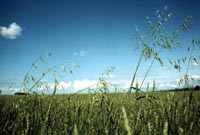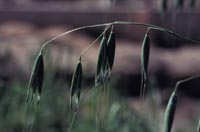| | Life cycle | Distribution | Germination | Reproduction | Emergence and growth | Flowers | Competition | Management strategy (lines of defense) | Control mechanisms
Avena fatua
Life Cycle
An annual grass that reproduces by seed.

Distribution
Wild Oat occur in almost all cultivated fields in Alberta but are less severe in the south-east of the province.
Germination
Wild Oat germinate throughout the growing season. The main flush occurs in the spring with a secondary flush in the fall. The germination period varies as much as three weeks, depending on weather conditions. Under warm and moist conditions, the main flush can occur over a short period of time and before crop emergence. Under prolonged cool weather, germination may continue until after the crop emerges.
The optimum soil temperature for the germination of wild Oat is between 16 and 22 degrees Celsius. Germination is slow at 4 degrees Celsius and very slow at 33 degrees Celsius. Most germination occurs at depths of 2 to 5 cm if soil moisture is adequate. However, if the surface layer is dry, germination can occur at depths up to 20 cm.
The wild oat seed will not germinate while exposed to light; it must be buried. Seed can be buried naturally by wind drifted soil, soil washed by water or through its unusual self-burial process. When wild oat seed is moistened, the awn unwinds. As the seed dries out the awn twists again. Alternate wetting and drying enables the wild oat to bury itself, thereby satisfying one condition for germination.
Emergence and Growth
Most wild Oat germinate and emerge in early to mid-spring. Cool, moist conditions promote maximum emergence, so crops that are seeded early are usually the most heavily infested. Fall or early spring applications of nitrogen fertilizer stimulate germination. Growth of roots and shoot of wild Oat is slow for the first two weeks, but increases quickly from then on. Most wild Oat tiller within a month of emergence.
Flowers
Wild Oat usually start to flower in early July and may continue to flower for up to six weeks. Seeds at the tip of the main axis of the panicle may ripen and fall to the ground before the seeds at the base are filled. Seeds shatter as they mature and are shed by mid-August, generally before the crop is harvested.

Reproduction
- Seed
Mature seeds of wild Oat are usually dormant when they shatter. Dormancy is broken by warm, dry conditions after the seeds ripen. If moisture is available when dormancy is broken, the seeds will germinate; otherwise they become dormant again.
The annual rates of seed germination are:
- The spring following seeding - up to 80 per cent.
- The second spring following seeding - up to 97 per cent.
- The remaining 3 per cent may have what is termed deep-seated dormancy and can germinate for up to 12 years.
- Vegetative
Though not a major method of reproduction, wild Oat are capable of vegetative regeneration. Wild oat plants can be transplanted and regrown if cultivation is incorrectly or incompletely carried out, and field and weather conditions are good for plant growth. Even severely injured (mutilated, sectional or segmented) wild oat plants are capable of vegetative propagation.
Competition
Competition is greatly influenced by the relative emergence dates of wild Oat and the crop. If wild Oat emerge before the crop, yield losses are greater than when the crop emerges first. Density and rates of growth of the weed and the crop alone influence competition. Increased growth rates and densities of wild Oat increase crop yield losses. The following table shows the estimated yield losses caused by various densities of wild Oat in four crops. The actual losses may vary from year to year depending on climatic conditions.
Wild Oat per ft2 | percentage yield loss wild Oat and crop emerged at the same time | Time of emergence* factor (+/-) |
 | Barley | Wheat | Canola | Flax |  |
0.5 | 5 | 8 | 7 | 14 | 0.5 |
1 | 8 | 11 | 10 | 20 | 1 |
2 | 11 | 16 | 15 | 28 | 1 |
3 | 13 | 19 | 18 | 34 | 2 |
5 | 17 | 25 | 24 | 44 | 2 |
8 | 21 | 32 | 30 | 56 | 2.5 |
10 | 24 | 35 | 33 | 62 | 2.5 |
15 | 29 | 43 | 41 | 75 | 3 |
20 | 34 | 50 | 47 | 88 | 3 |
| *The time of emergence information was developed experimentally for barley and wheat only. However, it may also be accurate for canola and flax. Add or subtract the appropriate number for every day wild Oat emerge before or after the crop. For example, if wild Oat at 2 plants per square foot emerge 3 days before barley, the yield loss changes from 11 to 14 per cent. |
Management Strategy (Line of Defense)
- Prevent seed production.
- Encourage germination of existing seed reserves.
Control Mechanisms
Preventing seed set of wild Oat in annual crops is very difficult unless the crop is taken off early for greenfeed or silage. Therefore, a combination of cultural and chemical control methods are needed to attack a wild oat problem.
- Tillage
Summer fallow - Summer fallow increases the number of seeds that break dormancy. A new stand of wild Oat will emerge after each tillage operation. Summer fallow can be grazed to control wild Oat. Seed fall crops in the same year as the fallow to provide competition against wild Oat that germinate in the spring.
Pre-seeding tillage - Till as early as possible after spring thaw. This warms and aerates the soil and stimulates early germination of wild Oat. Early tillage of heavy, wet soils is particularly important.
Tillage prior to seeding should be done before weeds reach the three-leaf stage. This minimizes the moisture and nutrients they use. Tillage should be to a depth of 2.5 to 5 cm during warm, dry weather so the wild Oat cannot re-establish.
Post-seeding tillage - Post-seeding tillage is valuable because wild Oat that emerge before the crop are more competitive than those that emerge with or after the crop. Till before crop emergence to prevent any crop damage. A shallow cultivation with a rod-weeder or harrows will eliminate wild oat seedlings.
Fall tillage - Fall tillage is useful if wild oat seeds have been exposed to two or three weeks of warm, dry weather. A shallow tillage will lightly cover wild oat seeds and promote early germination in the spring. A cultivator is more suitable than a discer or harrow. If fall weather is cool and moist, avoid tillage so that dormant wild oat seeds remain on the surface exposed to the elements.
- Mowing
When an infestation of wild Oat is moderate to heavy, and the crop is of low density, mowing is an effective preventive measure. Wild Oat should be mowed at the shot-blade stage. Early mowing can result in wild oat regrowth and seeds can still be produced.
Mowed wild Oat can be used for greenfeed or, if some of the seeds have set, for silage. The fermentation process will destroy wild oat seed viability.
- Rotation
Fall-seeded crops emerge early the next spring and can smother the emerging wild Oat. Fall rye is generally more vigorous and competitive than winter wheat.
Land seeded to perennial forage for three or more years can provide good control for heavy infestations of wild Oat. However, some wild oat seeds can survive under sod and germinate when the sod is broken.
A green-feed crop such as Oat can be seeded early to enable a competitive advantage over the wild Oat. To prevent weed seed production, cut the crop before the panicles of wild Oat start to emerge from the sheath. Silage effectively destroys any seeds produced.
Use annual crops in the rotation, especially the more competitive crops so that yield losses are minimized and the wild Oat are suppressed. In descending order, barley, canola and wheat are the most competitive small grains.
- Delayed seeding
Delay seeding to allow time for wild oat seedlings to be destroyed by tillage before or at seeding. Seed an early maturing crop such as barley. Yields may be reduced if seeding is delayed by more than 10 to 14 days.
- Fertilization
Nitrogen fertilizers broadcast in the early spring can stimulate wild oat emergence. This can enable more complete control prior to seeding. Phosphorous fertilizer drilled in with the seed promotes more vigorous crop growth that helps to smother wild oat plants and reduce wild oat seed production.
 | Seed yield (bu/ac) |
Phosphorous fertilizer placement | Barley | Wild Oat |
Control - no fertilizer | 33 | 12 |
Drilled with barley | 62 | 5 |
- Multi-technique approach
Like most other weeds, successful control of wild Oat will require a combination of tillage, crop rotation and chemical control. Each situation has to be evaluated and the appropriate control method(s) taken. |
|